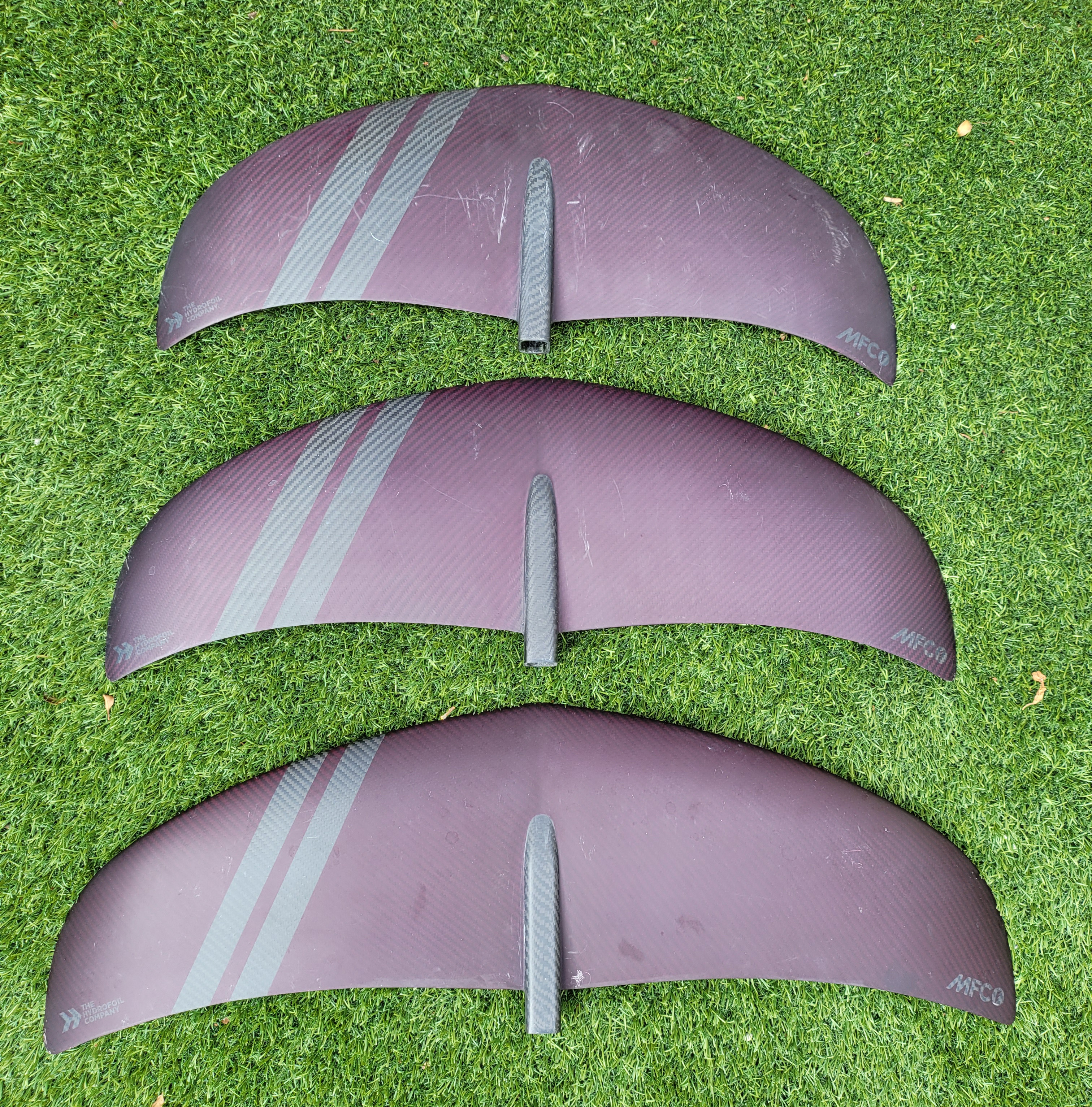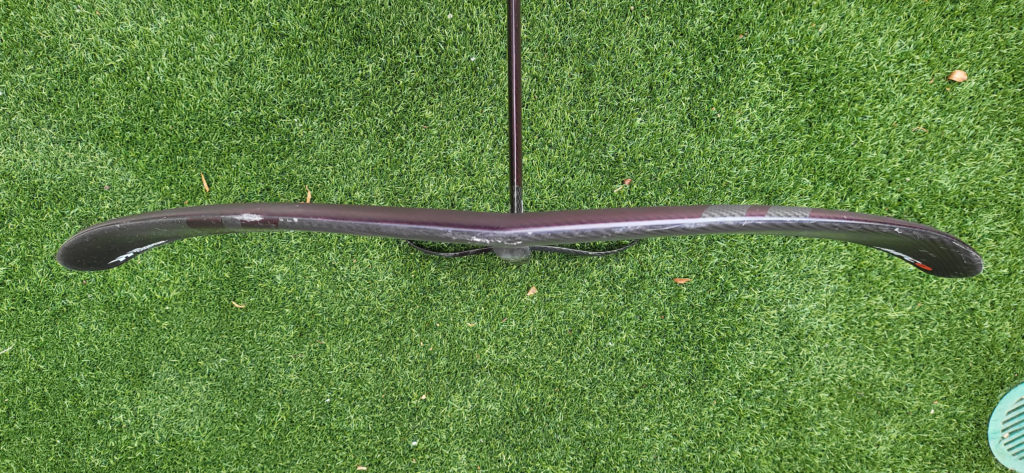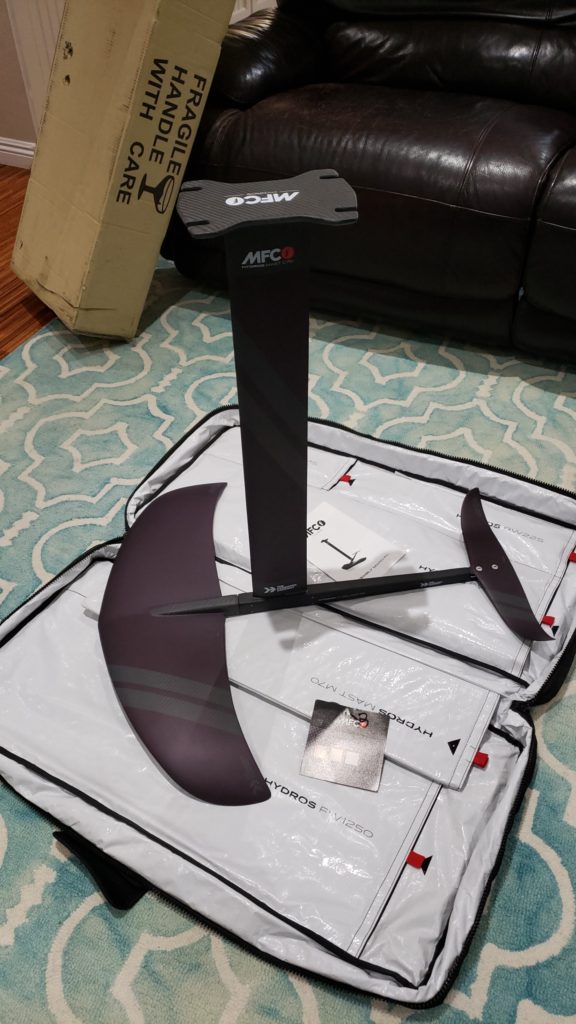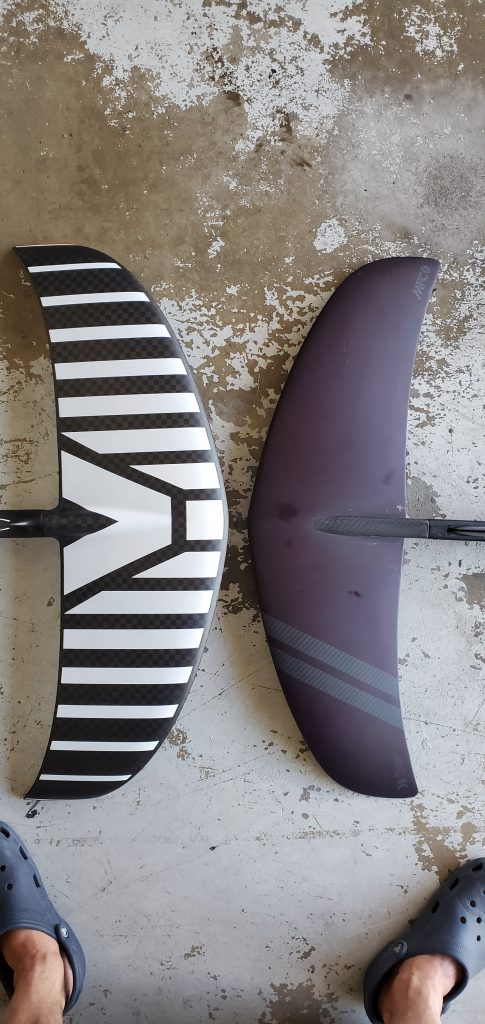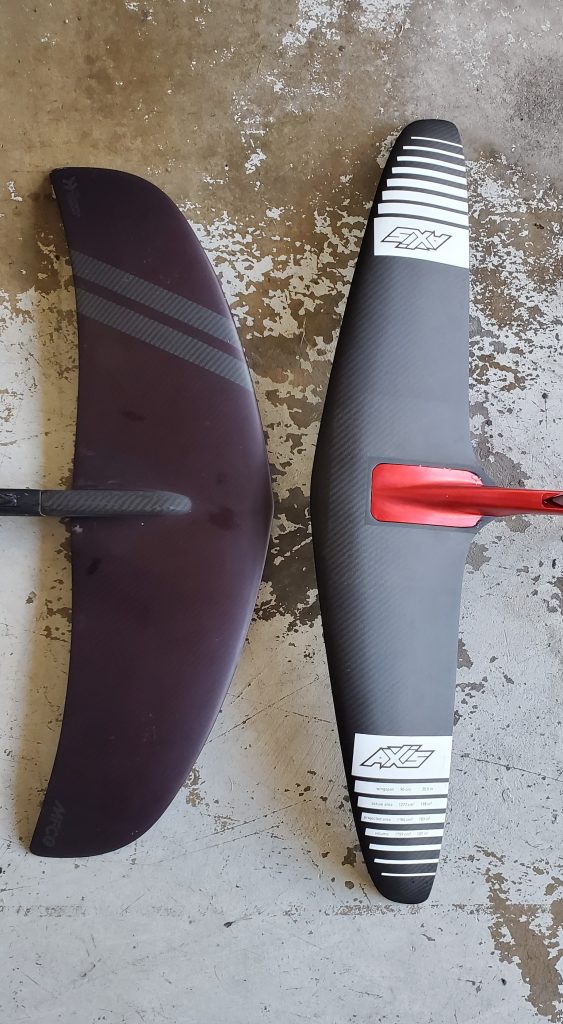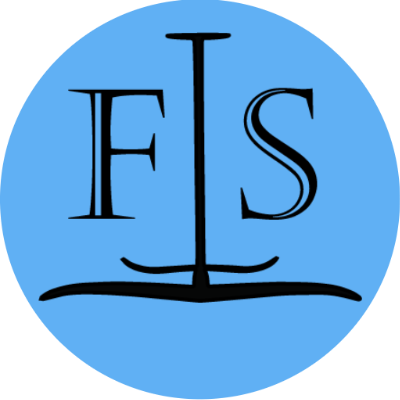The Hydrofoil Company
MFC Hydros
Foil Review
My Ride Profile
- I am an intermediate rider
- I started riding February 2018
- I ride 3-5 times a week as work lets me, but this is my average.
- I can pump out to a second wave or the line up 60% of the time (Oct 2019)
- The bigger the wing the better the chance of pumping out.
- I am 5’4” tall and 140lbs
- I ride a 4’0” board about 32L volume
Introduction
The Hydros is a full carbon foil. It was designed and tested in Hawaii by MFC and The Hydrofoil Company. It was introduced in early 2018, but did not come out until late 2018, and even then, in limited quantities. I received mine in October of that year after putting an order in the month of April! The hype around this foil was massive and I was one of many wanting to get one and see if it was worth it. The Hydros comes in a single wing pack (either 1075 or 1250 wing size) and a double pack which included both wings. I have been riding this set-up since October of 2018. The wing selection has increased, and I have had the 1400 wing since August 2019. This is my opinion of the foil. I am not paid by MFC or The Hydrofoil Company and I paid full retail for mine. I will be giving each category of the foil a Surfdocsteve Score and then will total it at the end so if you want just the nitty gritty of it skip to that page, but please read the conditions so you understand the scoring. A 10 in any category may not be right for you!
Foil Stats & Finish
The Hydros is a full carbon foil. All the components are carbon, except for the bolts. The Hydros breaks down completely for easy travel. The keel(mast or strut) is 28.5 inches from board to fuselage attachment with an integrated base plate to help lighten the foil. The weight of the 1050 wing is 2.9kg(6.39lbs) and the 1200 wing 3.0kg(6.61lbs) and the 1400 wing(7.2lbs) totally assembled on my scale at home. There are two fuselage lengths now with the standard or 63 cm and a shorter one at 58 cm. I have both. The construction is high quality with the fit very precise. Each component fits tightly to each other with no gaps. The finish is one of the best with a combination of carbon layers and subtle coloring that is pleasing to the eyes. The wing design looks fast and the trailing edges are tapered to a fine line. The construction is light weight and with that the flex in the set-up is noticeable. This is not necessarily bad. It does require some adjustment in style and feel. What is more concerning with the light weight is the reliability. I had my keel crack at the baseplate area. I know of several others that had the same issue. The flex may make this more of an issue especially over the long term. MFC did warranty my issue but I would have been without a foil for over a month if I did not have another one to use. Surfdocsteve Construction score=?
WINGS (Please see Wing Theory Article for a better understanding of wing design)
Initially at the first production there was not much of a choice of wings, but fortunately now the choices have expanded. There is the 1050cm wing, 1200cm wing, 1400cm wing and 1600cm wing. All these wings are a double anhedral type of wing with a thinner foil height to chord ratio. I have the 1075, 1250 and 1400 wings. Here is a table of the wing’s dimensions.
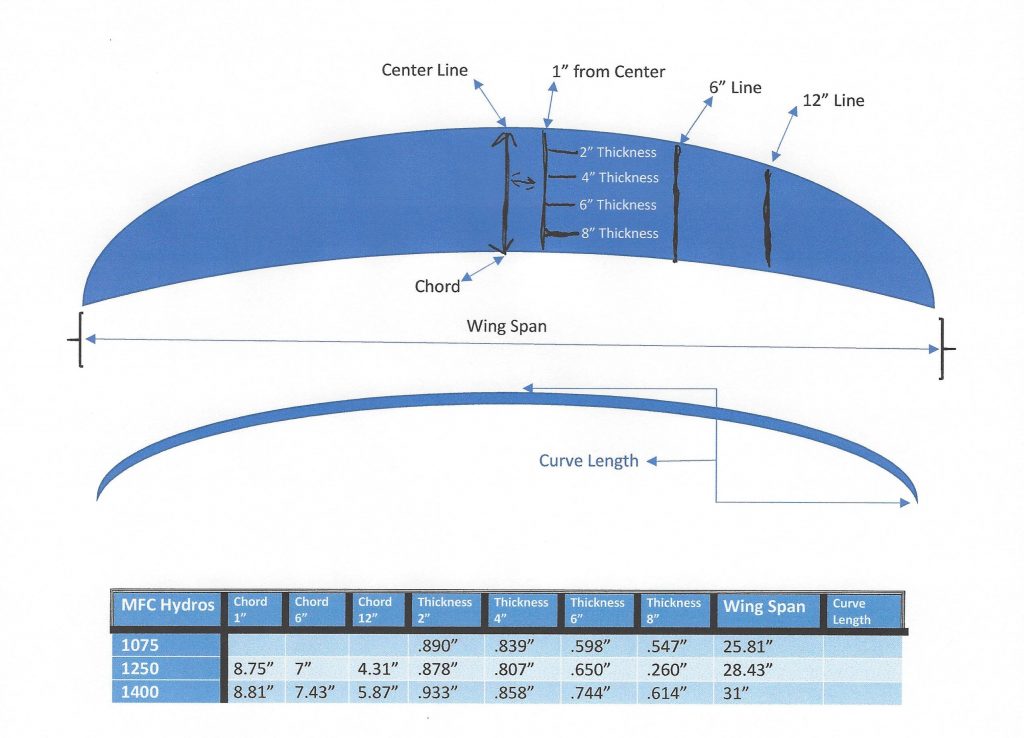
The wings are the key to the performance of the foil. This is one of the thinnest wings on the market and this makes the wings fast, but subtle in their lift profile. The angle of attack is small and this helps to make the take off easy and fast along with a linear lift profile. I found with the smaller wing I was able to make steep take-offs with confidence that I could not do with other wings I owned. When cruising down the line if you entered the sweet spot of the swell the wing would just keep accelerating to the point that making a turn was difficult. Even the 1400 wing with its massive area was very fast due to the thinness of the wing. The tail wings come in three sizes now. The smallest being 200cm, with a 225cm standard tail and a large 300cm. I have the 225cm and 300cm wings. I have mainly ridden the 225cm tail wing. It seems to work well with all the front wings that I own.
The Ride (Just my humble opinion)
I have ridden the Hydros in waves from 10 foot to 1 foot since October 2018 in a variety of conditions from Central California, Baja and Hawaii, but mostly on my home turf in Southern California. I switch between 1075, 1250, & 1400 wing depending on conditions and the size of the waves. Here is what I have found.
Lift Characteristics; The Hydros wings all have a very linear lift profile. During take off the wing slowly lifts out of the water and requires more speed to lift off the water. This is due to the lower angle of attack that the wing is set at. Lift is highly dependent on wing angle of attack and not the thickness of the wing itself. That being said the wing is rather thin compared to most other brands and this leads to its positive attribute of speed. The thinness of the wing increases it efficiency through the water and allows a higher speed to be attained in theory. The wings all have an immediate feeling of acceleration and top end speed.
Stability The Hydros is not the most stable set-up out there. This is not a bad thing. It is a very sensitive foil and highly responsive to your input. The wing requires speed and commitment. This makes the Hydros a Ferrari-like machine in the water. It will do what you ask of it and quickly. The Pitch on the standard fuselage is moderate in difficulty. The short fuselage will challenge your Pitch balance skills without changing the lateral stability of the wing. The short fuselage will make your turns tighter and slalom race type fun. The wings are very stable straight down the line. Initiate a turn and then you must up your game of balance. This is not a beginner foil. The Yaw is noticeable on the Hydros due to the thin keel. This can be disconcerting, but is not so much that it will cause any problems.
Turning: The Hydros is a turning machine. The wing lays over on edge rather easily and the smaller the wing the smaller the turning radius that you can make. Throw in a shorter fuselage and you are turning on a dime at G-force. That being said the turn has a more unstable feel than other more traditional wing designs I have tried. You have to constantly adjust fore & aft pressure (Pitch) to maintain the turn. It does not decelerate during the turns but maintains speed rather well and if you lay into it hard it will accelerate.
Flex: The Flex in the construction is noticeable. The keel is rather thin and this helps with the weight of the foil but leads to a fair amount of flex both torsional and side to side. I tend to not notice it as much as others due to my lighter weight, but I can tell when I switch foils. I am not sure if it is good or bad. The flex is noticeable, but flex is not always a bad thing. It can help you in and out of a turn if used properly. I would say if you are a heavy person then the flex maybe too much and annoying. I cannot give you an exact weight, but I would say if you are 170lbs and under then it would be good. Above that weight the flex may be too much. The flex issue could be solved by MFC making a thicker keel but his would increase the weight, which is one of the great things about the foil.
1075 Wing: This is the smallest wing and is very high performance. I started on this wing. It is very fast. The amazing thing about the wing is that the wing feels stable even at high speeds. I remember getting a nice lined up wall at SanO on this wing and just blazing down the line at what felt like a million miles per hour, but at the same time felt in complete control. I have fallen off at this speed and skipped along the water before penetrating the surface! Fast. Taking off on steep waves with this wing is a pleasure. It mostly requires some faith on my part that I am going to make it. The wing does not jump out of the water and it is just a matter of proper balance to make those drops. Pumping is harder on this wing. It requires a higher frequency pumping style and a lot of effort. If you keep your speed up then it is an exhilarating ride, but faulter and you go dead in the water rather easily.
1250 Wing: This is a great everyday wing. It has a lot more glide and pump to it than the 1075. Speed is not diminished much with this wing compared to the 1075. Turning is great but definitely needs some more technique and throttling of speed to keep control. The lift profile is the same as the smaller wing, and I was surprised that I did not need to change the position of the foil on the board from the smaller wing. I found that I could take-off on steeper waves with this wing as well but not as radical of a drop as the 1075 would let me. Pumping on this wing was much easier and let me get a taste of multi-wave rides. I am not a great pumper so I would estimate about 40% of the time I could pump out part of the way and if the next wave was close enough get on it. I had friends who could pump this size wing really well and get out to the line up, but they were younger than me and had the strength and stamina that I lack.
1400 Wing: This is one of my favorite wings right now. I am not a great pumper and I am not into radical turns, so this wing fits me well. The lift profile is very linear. The glide on this thing is insane compared to the other wings. When I ride the 1400 I am able to pump out to the lineup much easier and get second waves on a semi consistent basis, about 60% of the time. The pumping frequency is slower and I find that I can even pause in between pumps sometimes. The wing still turns well but nowhere near the level of the smaller wings. This is expected. What makes up for that, for me, is the ability to connect multiple waves via pumping. The smooth carving of this wing along with a relaxed pump frequency has taken my mediocre ability and raised it to a new level.
THE UGLY The Hydros is a light weight fine tuned machine. It is a race car for the water. Kind of like your high performance short board. It has a place in anyone’s quiver, but may not be the best all around set-up. The wing selection helps make up for that but if you buy all the options I have you are almost $4 grand in the red. This allows you to surf the wing in almost any condition that you may come across from 1 foot to 10 foot with paddling into a wave. The issue that stand out besides the expense are the flex and reliability issues. Kai Lenny shreds on the MFC, but I do not find that comforting since he could most likely shred on any foil or surfboard. What does it mean to the average joe like me. Flex is definitely something you feel and can make the foil feel jiggly or wobbly under your feet. I got used to it but it is an issue. This flex is what I think leads to the other issue which is cracking of the keel. I experienced this myself and at the time they could not even keep up with the demand so I waited well over two months to get a new keel. I would have been going crazy if not for a friend who did not like the flex either and made his own keel to counter that, which allowed me to borrow his keel until mine came in. I just sold a friend my Signature and when he met me in the water his MFC wing was in one hand and the keel still attached to his board! I know of others that are hesitant to purchase the system due to the above issues. I think they can solve these with a few adjustments to the keel and minimal weight addition. I hope they do since the wings are top notch.
THE OVERALL VIEW The Hydros is a great foil. Despite all the issues I would still buy the foil since I think the wing design is that good. No one except the Signature Stealth comes close in wing design and high performance type of foiling. I think you could not go wrong having this set-up. The weight, finish and wing design are top notch. The flex is a debatable issue and its role in performance is still up for debate. The reliability is still questionable with the connection of the keel to the fuselage. I personally think this type of connection is flawed and prone to issues, but it is what 90% of the manufactures use. Armstrong is the only one I know of that has addressed this issue well with the slide through connection. The flex issue along with the reliability would be solved with a redesign of the keel and fuselage interface. Besides those issues, the rest of the set-up is built well. The wing design is fantastic, and I would not change any of those but just keep adding more wing options.
